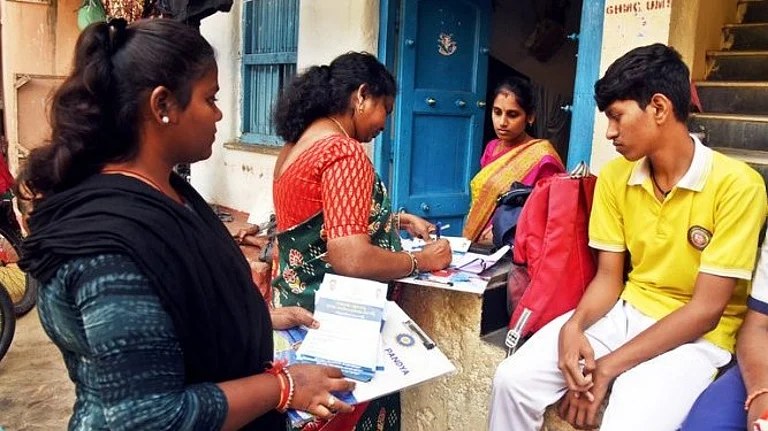IT was another kind of pilgrimage by a different kind of parivar . There were no trishul -wielding, saffron-clad mobs chanting Jai Sri Ram, nor did they visit any pilgrim spot. Virtually unnoticed by the media, from March 14 to 19, some 70,000 Swadhyayees from Maharashtra, Gujarat, Goa and northern Andhra Pradesh stormed 6,700 villages and 100 cities of Haryana, Delhi, Rajasthan, Punjab and Uttar Pradesh to seek the 'indwelling God' among their denizens. On March 20, they converged at Kurukshetra where founder and 76-year-old Vedic scholar Pandurang Shastri Athavale, fondly called Dada (elder brother), addressed a lakhstrong gathering.
Founded in 1954, when, along with 19 youths, Athavale went on the first such bhakti pheri (pilgrimage) to Saurashtra, today the Swadhyaya movement has two lakh 'active' adherents from all walks of life—industrialists, businessmen, lawyers, farmers, fisherfolk, beedi workers, harijans and tribals—who have rejected caste and class barriers and meet as equals. Concentrated mainly in the three western states and pockets of Orissa, Andhra Pradesh and Haryana, the Swadhyayees religiously perform bhakti pheris for a total of 15 days a year and, over the past four decades, have brought about a silent 'social and economic transformation' which has astounded social scientists.
Eminent sociologist J.P.S. Uberoi is 'amazed' that such teamwork is possible in India and believes Swadhyaya offers truly indigenous development solutions. Former director of the Indian Institute of Management, Ahmedabad, Narayan Sheth, describes it as an "exceptional intervention in society". And D.L. Sheth, senior fellow at the Centre for Study of Developing Societies, marvels at the 'holistic vision', saying, it addresses a range of dichotomies of the Indian society.
In some 80,000 villages where it reportedly holds sway, Swadhyaya has used the notions of human dignity and bhakti (devotion) as a creative force to generate vast amounts of 'impersonal wealth' among farmers and fisherfolk (shared as prasad ), promoted afforestation and gender equality, demolished caste barriers and, without preaching, put an end to drinking, wife-beating, gambling, even dacoity and smuggling—all through a process of patient and sustained spiritual dialogue which noted film director Shyam Benegal has depicted in his film Antarnaad (Inner Voice).
But, what is Swadhyaya and how does it work? "Swadhyaya," explained Bombay industrialist Maheshbhai Shah, "literally means selfrealisation. According to Dada, God is our partner and dwells within us. Since all humans share this inborn divinity, they are blood brothers and our bhakti entails bringing out the best and most efficient in ourselves and sharing it with others."
Each Swadhyayee performs kriti bhakti or creative devotion which entails offering one's efficiency to God. Villages with 60 per cent or more Swadhyaya influence practice yogeshwar krishi (divine farming) where, as bhumiputras (sons of the soil), they take turns to cultivate a common plot. In clusters of 20 or more such villages, the villagers buy, say, a 40-acre plot ( shreedarshanam) , on which a fixed number of Swadhyayees from each village work as per rota. An individual's turn may come once or twice a year.
Similarly, Swadhyayee fisher folk or sagarputras (sons of the ocean) perform bhakti on commonly-owned boats called matsyagandhas (floating temples). Costing about Rs 3 lakh, the funds for these boats are raised over a period of time by devoting a day's catch by turn. The produce from these agricultural and fishing activities is 'divine' and the wealth generated is the 'impersonal wealth' of the Swadhyaya parivar. Trusted to the custody of elders, it is distributed as prasad to the needy in a quiet manner whereby none other than the recipients come to know about it. To date, there exist 3,396 yogeshwar krishi networks, nine shreedarshanams and 42 matsyagandhas . In addition, Swadhyayee engineers and technicians have tapped rainwater to recharge 94,465 wells and 208 dry lakes.
Said Uberoi: "For those of who have been disillusioned by the planning model of the '50s and are wary of the primacy being accorded to the market mechanism, Swad-hyaya has shown a third option which is an alternate vision of modern India set in the continuing framework of the Bhakti Movement." D.L. Sheth added that Swad-hyaya has brought about social transformation through the revival of bhakti as an active principle of life and not as an escape mechanism for the elderly. "By emphasis-ing the development of one's potential and offering one's first-rate self to God, it improves upon Calvinism. The concept of inborn divinity results in vertical integration by breaking down caste barriers. It also acts as an effective anti-liquor movement without bamboozling anyone or imposing prohibition," he said.
And in Narayan Sheth's view, Swadhyaya's distinguishing feature is that "it has changed society in a manner whereby all gain and none is the loser. This, to my mind, has not happened in any other movement." Oxford historian Gopal Krishna adds that one need not be Hindu or even of a religious bent of mind to be moved by Swadhyaya as it is about spiritualism and is neither a religion nor a cult.
Many of the 9,000-odd Swadhyayees (500 of them NRIs) who came to the other -wise "cold" and "suspicious" city of Delhi were "overwhelmed" by the response of a majority of residents they reached out to. "At first the people were hesitant and thought we had come either to seek donation or votes. They couldn't believe people could come to call on them from so far away out of a sense of brotherhood alone," said Dr Manish Jadav from Ahmedabad.
During house-to-house calls, called bhav pheris in Swadhyaya parlance, the pilgrims accept neither food nor hospitality from the people they visit. They not only bear the expenses of the entire trip, they even cook their own food. Interestingly, they neither preach nor seek converts and simply talk about their sense of brotherhood with the rest of humanity and of their experience of self-transformation. "It does not bother us if some people are cold or even rude, we continue with our bhakti without letting our ego come in the way," said Madhu Patel, a criminal lawyer from Bombay.
At the end of the current phase of bhav pheris, the Swadhyayees will submit a list of names and addresses of families which responded positively to the Swadhyaya headquarter in Bombay, which will serve as a reference for those performing the next bhakti pheri in the area. Says Shah: "As elsewhere, subsequent bhakti pheris in north India will seek to do no more than the present one. Such pilgrimages are an act of our devotion. We don't have an agenda or tar-get in mind and for any Swadhyaya institution to be set up in these parts, the people themselves will have to come forward and seek them. This may take years, decades or may never happen, but the bhakti pheris will continue."
Given its large following, a question that arises is whether this hitherto apolitical movement runs the risk of getting politicised? The unanimous verdict of academicians observing it closely is: "impossible". According to D.L. Sheth: "Its very core is such that it cannot be politicised in the ordinary sense. Their aim is not to show strength and to Swadhyayees, power means power of the self." It would be music to T.N. Seshan's ears to know that during elections Swadhyaya villages do not allow the distribution of liquor nor do they permit election graffiti on their walls. "In fact, they erect a podium themselves and give each candidate a fixed slot in which to speak and leave them to make up their mind," revealed Sheth.
Uberoi, on the other hand, "wishes" that Swadhyaya had a political agenda, but concludes that the movement has "shifted away from the affairs of State and lure of the material by renewing the institution of civil society which is of a community nature, a large family, but includes religious institutions. For them to enter politics, politics itself will need to be redefined as self-management of community and not merely of the affairs of State."






















